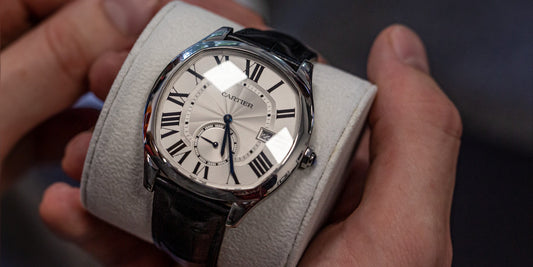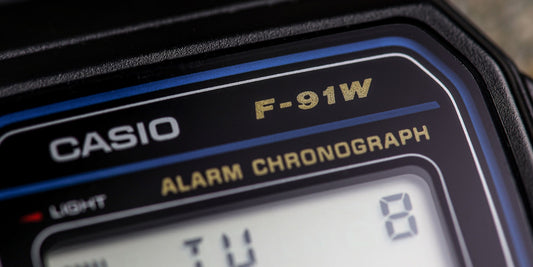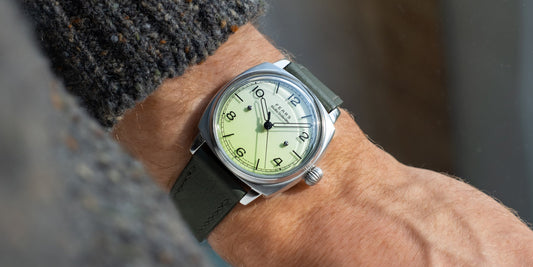Discovery. The brand’s one-word motto says it all. Arcanaut is on a mission, a journey, a quest for true novelty. And not the kind of novelty we’re used to seeing in the watch industry. Far from it. Arcanaut is obsessed with creating watches that make you do a double take, stop you in your tracks, and raise an eyebrow so far from its resting place, that it might very well break your forehead.
 Fordite Angel's Landing - Credit Arcanaut
Fordite Angel's Landing - Credit Arcanaut
Although best known for its wild and arresting Fordite dials (more on those later), not everything this plucky Danish outfit does is quite so “in your face”. Released earlier this year, the D’Arc Matter Colours Collection provided the brand with a foundational range that looks set to return (with some minor modifications) in the future. The recently released Havender and Klint lines build on the technologies developed for the original D’Arc Matter limited edition and take the brand’s core aesthetics in new directions.
The new kids on the block
A serene purple dial and a crisp white option may look straightforward enough to the naked eye, but the production processes of both (the former especially) are mind-blowingly laborious. So much so, that the men charged with executing this almost mythical form of alchemy have grown to hate their own creations before they even hit the shelves.
 Arcanaut Arc II Havender Limited Edition Watch 1 - Credit Arcanaut
Arcanaut Arc II Havender Limited Edition Watch 1 - Credit Arcanaut
“The Havender,” James Thompson (AKA Black Badger) says with a 1,000-mile stare. “It takes some making, that’s for sure. I know that when it’s on the wrist it looks harmless enough, but it’s nearly killed me in several different ways. That’s quite an achievement for something less than four centimetres in diameter.”
But what does he mean, exactly? The dial isn’t fitted with teeth or claws and, even though the composite itself is partly derived from organic material, it doesn’t hold a personal grudge against Thompson for bringing it to life. No, the Havender is such a tough beast to tame because, truthfully, it should never have existed at all.
 Fordite James's Giant Peach - Credit WatchGecko
Fordite James's Giant Peach - Credit WatchGecko
Mix it all up in a bowl...
Chance. Opportunity. Moments of inspiration. Actions that can be repeated but never truly replicated. Mistakes. These are some of the main ingredients of the Havender dial. That and around ten kilograms of Scandinavian blue mussel shells…
It all started with the D’Arc Matter dials. Having obtained (legally, if anyone asks) a small amount of Swedish slate, Thompson decided to introduce it to an industrial espresso grinder we call AMOS.
 Arcanaut Arc II Havender Limited Edition Watch 18 - Credit Arcanaut
Arcanaut Arc II Havender Limited Edition Watch 18 - Credit Arcanaut
As it happens, AMOS was so happy to meet the slate, that he pulverised it (which, despite a no more than rudimentary understanding of machines, we believe was meant as a sign of endearment). With his newly powdered metamorphic rock, James created a millable composite. He did this by mixing the dark dust with an ultra-clear, UV-resistant binding agent (resin). The resulting slab cured to a rock-hardness that made it suitable for CNC milling, allowing Arcanaut’s new dial design to be realized not just on the material, but in it.
The original D’Arc Matter series was limited to fifty pieces. It had white lume and thin stainless steel hands with white tips. It was an instant success and sold out quickly. Many of those initial purchasers have returned to buy more from Arcanaut. Many of them have become good friends. And a good group of friends is what you need backing you up when you set out to create a dial as challenging as the Havender.
 Arcanaut Arc II Havender Limited Edition Watch 5 - Credit Arcanaut
Arcanaut Arc II Havender Limited Edition Watch 5 - Credit Arcanaut
She sells seashells on the seashore...but not like this...
A short drive from Gothenburg, where James Thompson and the Badger Den are located, is Sweden’s largest blue mussel farm. Being Swedes, they are very friendly and were quite taken by our request for a box of their discarded shells.
Returning home with ten kilograms of “waste material”, James set to work. First, the periostracum membrane, which hardens into a brown, bone-like mass on the outside of the shell when they dry out, has to be removed. Then, the shells must be cleaned and dried to bring out their true colour. At this point during our first experiments, we became convinced that the pigment we would be able to derive from these molluscs would be blue. We were very excited about that. We were also very wrong.
 Arcanaut Arc II Havender Limited Edition Watch 22 - Credit Arcanaut
Arcanaut Arc II Havender Limited Edition Watch 22 - Credit Arcanaut
After much trial and error, we realised that only the middle part of the shell would yield useable pigment. The base (something we call the “knuckle” of the shell) is far too tough and gritty to use in a composite that has a luxury application. We need homogenous grain size and as little colour variation as possible for it to work, and so that part of the shell is ignored.
The upper rim of the shell is also unsuitable for use. Here, however, the shell is thin and brittle. It shatters like glass. Its fibrous detritus is totally unusable in such a composite for fear of it catching the light and the eye once milled and finished.
Instead, the middle part of the shell, the “Goldilocks” zone, provides exactly what is needed to create a molecularly stable and visually homogenous block of millable material ready for machining.
 Fordite Stone Cold Cowabunga - Credit Arcanaut
Fordite Stone Cold Cowabunga - Credit Arcanaut
The Klint: the quiet assassin
And then there’s the Klint. It is perhaps the finest example of what the brand has learned thus far. It takes the experiences of the D’Arc Matter and Havender models and streamlines the production process, making it much less work to produce than either of its composite peers.
 Arcanaut Arc II Klint Watch 3 - Credit Arcanaut
Arcanaut Arc II Klint Watch 3 - Credit Arcanaut
The difference with the Klint is that the research and development phase was even longer than those of the Havender and the D’Arc Matter. With darker colours, the process is easier. The darker the target colour is, the more flexibility there is in the recipe. For a white dial, everything has to be perfect. There can be no imperfections. Remember, the goal is to achieve the whitest of the white dials and that is only possible with a material that is pure as snow and strong enough to be milled.
Enter titanium dioxide. It is the basis of most paints and so a well-known compound in the decorating trade but was nowhere near the top of the list when Arcanaut started exploring white materials.
 Arcanaut Arc II Klint Watch 7 - Credit Arcanaut
Arcanaut Arc II Klint Watch 7 - Credit Arcanaut
Weeks into the process, the brand stumbled across this particularly bright white powder and began experimenting with the right volume of it and ultra-clear, UV-resistant resins immediately. After a few days of near catastrophe, James emerged with a dial material that was not only white but also boasted a beguiling texture that made the most of its composite status.
Of all the dials Arcanaut has created thus far, the Klint is perhaps the strangest to behold. It has an almost waxy quality to it, which pulls you in just beneath its surface. The black-tinted stainless steel hands provide extreme legibility, while the redesigned “Chevron” handset ensures good low-light legibility without sacrificing the daytime clarity of the dial. Tone-on-tone Lumicast hour markers complete a look which transforms at dusk, going from a monochromatic display to a glowing ghostly vision on the wrist.
 Arcanaut Arc II Klint Watch 14 - Credit Arcanaut
Arcanaut Arc II Klint Watch 14 - Credit Arcanaut
The big boy in the corner
Composites aside, perhaps the most famous products in the Arcanaut range are the brand’s unique Fordite pieces. Their swirling, psychedelic dials have been turning heads for over a year now ever since James Thompson brought a process he first explored with TAG Heuer and George Bamford in-house.
Fordite is also known as Motor City Agate. It is a byproduct of the automotive industry in the latter part of the 20th century. In those days, the paints used in car manufacture were heavy, lead-based paints that cured to a rock-like hardness and gained a reputation for being almost indestructible when dry.
 Fordite Say Goodbye to your Wormhole - Credit Arcanaut
Fordite Say Goodbye to your Wormhole - Credit Arcanaut
The spraying bays used in those days were neither as refined nor as clean as their modern equivalents. The overspray that missed whatever component was being decorated would land on the walls, ceilings, floors, and jigs used to support the various elements of car creation. Over time, this paint would harden. It would remain in place, continually curing in that perfect environment, for years at a time before the overspray became so thick and obtrusive it needed to be broken off so work could continue.
Chunks of dried paint, sometimes three or four inches thick, were disposed of willy-nilly until some bright spark realised their aesthetic value. When one breaks open a lump of this stuff, years of hard labour are revealed in inimitable patterns that offer a glimpse of the past. It’s an odd thing to countenance: every one of the colours on every single Fordite dial painted a car that became a central part of someone’s life. These cars drove people to school, to work, to hospitals, weddings, funerals, and more. They played their part in the establishment of America as it is today. They are time capsules. And each one is entirely unique.
 Fordite Psychotechnic - Credit Arcanaut
Fordite Psychotechnic - Credit Arcanaut
It’s hard to put into words exactly how unique these pieces are considering how painfully overused that word is in our industry, but allow me to try: the Fordite dials of Arcanaut aren’t just unique because Arcanaut has decided to make each one once; no, they are unique because they couldn’t be remade even if the brand wanted to.
Unique by nature
 Fordite Optimus Slime - Credit Arcanaut
Fordite Optimus Slime - Credit Arcanaut
There are two key steps to the uniqueness of these dials. One is the fact each one is hand-finished by James Thompson who removes micron after micron with the utmost care. The second point is that the material he’s working on is a happy accident. It was not made as much as it was born of a separate creative process that, while itself could be replicated in the sense the same cars could be sprayed with the same colours, in the same order, the resulting overspray would never, ever form identically. Perhaps this is why some people refer to Fordite as a man-made mineral? Something that would not exist were it not for us, but has its own ungoverned nature.
Personally, I treat it as I’d treat a meteorite. It is a material created of and by time. And, crucially, it is a finite resource. There will be no new Fordite made. In the late 20th century, health and safety regulations changed and the old paints were replaced with safer, water-based alternatives that simply do not cure in the same way. And while Arcanaut has a decent supply of Fordite left and a reliable contact in Detroit who sells them their blocks directly, it will run out one day (soon).
 Arcanaut Arc II Klint Watch 13 - Credit Arcanaut
Arcanaut Arc II Klint Watch 13 - Credit Arcanaut
It surely isn’t for everyone, but the story is fascinating regardless of whether you wind up with one on your wrist or not. For me, it is a pleasure to be involved with a brand that is doing things the right way, a brand that is pushing the envelope on all fronts. That’s what watchmaking should be about, in my opinion. And now, more than ever, we need more brands to do the same.
















